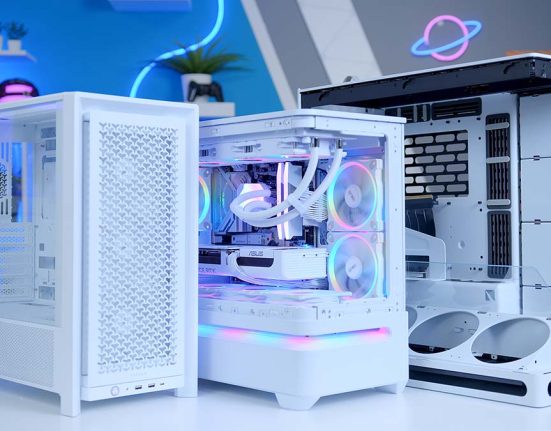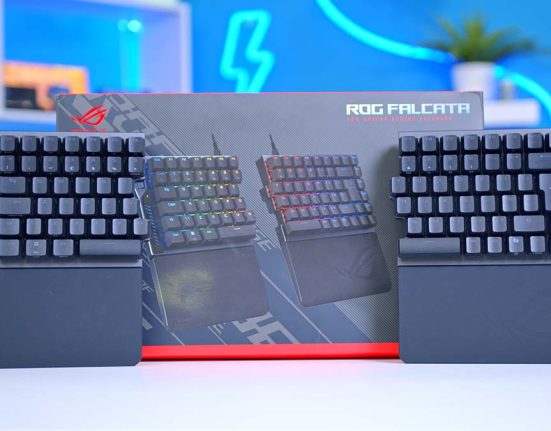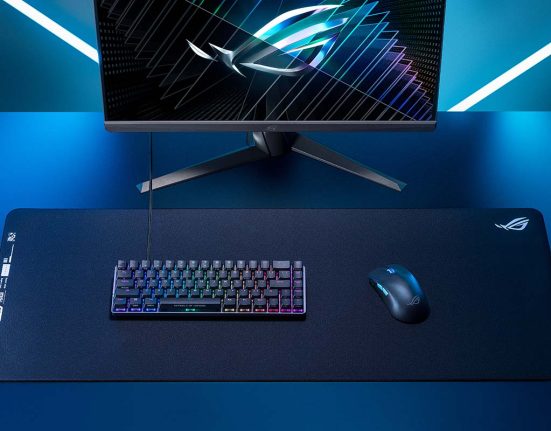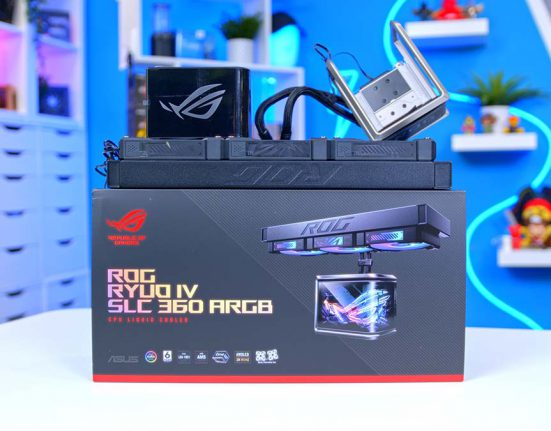The TUF GT502 Horizon ARGB is ASUS’s take on a panoramic dual-chamber PC case designed to showcase all of the components inside. It features four pre-installed addressable RGB fans, offers ample space for various cooling configurations, and a modular design language that alleviates numerous elements of the hassle factor when building a PC.
However, the dual-chamber open-view approach isn’t exactly new and something we’ve seen before from a vast range of manufacturers. This puts considerable pressure on ASUS, as the TUF GT502 Horizon ARGB comes in at a substantial $199.99 MSRP, which is a notable increase compared to some of the other competitors on the market. This is why we’ve put the ASUS TUF GT502 Horizon up to the test to determine if its rather hefty price point is justified.
In this case review, we’ve conducted a comprehensive analysis of the GT502 Horizon ARGB, assessing its specifications, design, and features to determine if it’s a worthwhile option among the multitude of dual-chamber cases already available.
Buy the ASUS TUF GT502 Horizon ARGB on:
Specification
On paper, the ASUS TUF GT502 Horizon ARGB features a solid set of specs. First and foremost, this is a mid-tower dual-chamber case, so in terms of encumbrance, you’ll have no trouble fitting it underneath most desks. However, as a showpiece, we can understand that many prospective buyers will want to display it front and centre to showcase its design.
Regarding motherboard support, the GT502 Horizon has space for Mini-ITX, Micro-ATX, and ATX PCBs, which is a fairly standard configuration across most mid-tower cases. Unfortunately, ASUS doesn’t specify support for BTF or other reverse connector designs on the product page, which means that if you plan to upgrade to any of the latest reverse connector chipset options, you’ll have to purchase a different case.

The IO selection on this chassis is fairly standard, with three ports in total, comprised of one USB 3.2 Gen2x2 Type-C port and two USB 3.2 Gen1 Type-A ports. While it would be nice to see a greater selection, I think three will be ample for most builders. There’s also a 3.5mm combo jack for a headset or pair of headphones.
Clearance-wise, the TUF GT502 Horizon ARGB has space for CPU air coolers up to 163mm tall and graphics cards up to 400mm long. The vast majority of long GPUs tend to cap out at around 370mm, so there’s plenty of additional clearance here beyond the length of the graphics card. For PSU space, you’ve 200mm of length to work with, which is ample.
| Specification | ASUS TUF GT502 Horizon ARGB |
|---|---|
| Form Factor | Mid-Tower |
| Motherboard Support | Mini-ITX, Micro-ATX, ATX |
| Case Dimensions (L x W x H) | 446mm x 450mm x 285mm |
| Front IO | 1 x USB 3.2 Gen2x2 Type-C 2 x USB 3.2 Gen1 Type-A 1 x 3.5mm Combo Jack |
| PCI-E Slots | 8 + 3 vertical |
| Colour | Black/White |
| Max Clearance | 163mm Cooler Height 400mm GPU Length 200mm PSU Length |
| Drive Support | Up to 4 x 2.5 inch Up to 4 x 3.5 inch |
| Fan Support | Top: 3 x 120mm Rear: 1 x 120mm Side: 3 x 120mm Bottom: 3 x 120mm Rear Chamber: 3 x 120mm |
| Radiator Support | Top: Up to 360mm Side: Up to 360mm Rear: Up to 120mm Rear Chamber: Up to 360mm |
| Pre-Installed Fans | 4 |
Fan and radiator support is where this case thrives above all else. Four panels support up to three 120mm fans, providing a total of 13 fans. Alternatively, those looking to liquid cool their PC also have three spots to install a 360mm radiator. It’s particularly impressive that ASUS are utilising the extra space in the rear chamber for cooling, as this is typically reserved for cables.
The last major point to cover is pricing. As mentioned in the introduction, the TUF GT502 Horizon ARGB is priced at $199.99. A cheaper version is available for around $160, but it lacks fans, so the extra $40 may be worthwhile for some. I think $200 is quite steep, just based on the specs. Cases like the Antec C5 Constellation or the Montech King 95 Pro are similar in terms of support and design, but offer additional features or design elements while being considerably more affordable. At $200, you’re teetering into high-end territory, which means the TUF GT502 Horizon ARGB needs to offer some pretty unique qualities.
ASUS TUF GT502 Horizon ARGB Design
As far as design goes, the TUF GT502 Horizon ARGB is a good-looking case. ASUS has opted for a more cube-like aesthetic, which results in a straight and uniform appearance compared to the curvier design of a case like the Montech King 95 Pro. This chassis features two tempered glass panels: one on the side and one on the front. The front glass panel isn’t extensive, as this area is occupied by a large strip of metal that houses the front I/O towards the top of the case, which also indicates a relatively large dual-chamber at the rear.

Despite the front tempered glass not being massive, it still provides a large window into the case, showcasing all the components inside. Specifically, the ARGB version features three 120mm reverse fans mounted on the side and an additional 120mm fan at the rear, all of which illuminate with RGB lighting around the ring and the edge of the fans.
After removing the front and side glass panels, there’s plenty of internal space to leverage. ASUS prides itself on the TUF GT502 Horizon ARGB being fully modular, allowing you to remove the top panel mounting to easily access areas such as the CPU power and main fan headers. The largest form factor supported by this case is ATX boards, with the standoffs pre-configured to accommodate an ATX board straight out of the box. There are cutouts at the top with rubber grommets around them, providing ample room to thread cables through, along with two additional cutouts at the bottom for headers such as HD Audio or your GPU cables.
Regarding clearances, the TUF GT502 Horizon ARGB has 400mm of length to accommodate graphics cards and 163mm of height for CPU coolers. Most modern GPUs tend to cap out at 360mm, so there’s ample clearance here to install a large card, such as an ASUS ROG Astral model. You’ve also got space for three 120mm fans on the side and three 120mm fans on the top. Alternatively, these panels support 360mm radiators if you’d prefer to maximise your liquid cooling capabilities.
Moving around to the rear chamber, this is where you’ll install your power supply and manage any cables. One of the unique qualities of this area of the case is that it also supports an additional three 120mm fans or an extra radiator. This will make cable management slightly more challenging, but the added airflow will be worth it for many.

Without the fan/radiator mounting panel in the rear chamber, there’s plenty of room to cram cables in. I must say that I was quite disappointed with the lack of anchor points in this case. There are only a few areas to tightly secure cable ties, so it may prove difficult for first-time builders to appropriately manage and tie everything down.
The last area to cover from a design perspective is the top panel. Four metal bars around the corners protrude from the top, covered in a fabric strap. These act as carry handles, allowing you to easily transport this chassis with minimal hassle. This isn’t a must-have for all new cases, but it’s a nice touch that enhances the usability factor.

Overall, I like the design of the TUF GT502 Horizon ARGB. Aesthetically, it is somewhat plain compared to other dual-chamber cases. With the chassis being more cube-like, it’s closer to a standard ATX case, but it’s much wider, offering more space. I like that the RGB fans are a bit different, and they complement the more simplistic tone of the chassis. The dual tempered glass panels offer an unhindered view of your build, which, again, is great to see. There’s also a decent front IO selection to utilise, which is excellent for those with plenty of peripherals.
As a general rule of thumb, most TUF components tend to strike a good balance between aesthetics and functionality, and the TUF GT502 Horizon ARGB is sticking to that philosophy.
Features We Like
Highly Modular
One of the principal features of the TUF GT502 Horizon ARGB is that it’s massively modular. The case can be disassembled down to the bare bones frame, allowing you to access the internals easily. Since the majority of the panels are toolless, this process is seamless, saving you time and hassle during building.
Ample Space for Fans
Across the entire case, builders have a vast amount of room to leverage for fans and coolers. The TUF GT502 Horizon ARGB supports a maximum of 13 fans across the entire case or three 360mm radiators on the top, side, and rear chamber panels.

Features We Don’t Like
No Support for BTF Systems
I believe one of the most significant drawbacks of this particular case is that it does not support reverse connector motherboards. Many new case releases are designed to accommodate standard and reverse connector boards in the wake of motherboard chipsets that were announced at Computex 2025. However, despite the rather high price point of this chassis, ASUS doesn’t appear to be catering to BTF systems with the TUF GT502 Horizon ARGB.
Tricky Cable Management
One of the other downsides of this case is that cable management can be tricky. In the rear chamber, there aren’t a massive number of points to anchor cables, which means you may have to find some creative ways to ensure your wires stay clear of any vents and remain clean and tidy. This becomes even more unmanageable if you decide to install additional fans or a radiator in the rear chamber.

Conclusion
ASUS TUF GT502 Horizon ARGB
Product Name: GT502 Horizon ARGB
Brand: ASUS
-
Features
-
Design
-
Versatility
-
Value For Money
Summary
The ASUS TUF Horizon GT502 ARGB is a case that I want to get excited about, but I struggle to do so because of a few factors. At a glance, the TUF GT502 Horizon ARGB appears to be well-designed. There’s ample space for fans and coolers; the chassis is quite modular and can be disassembled down to the bare-bones frame, making installation incredibly straightforward. Additionally, the TUF aesthetic of the case stands out, offering builders some unique visuals and plenty of RGB lighting across the fans and the case itself.
However, this particular chassis falls flat in the pricing department. While there are competitive options, such as the King 95 Pro or the Phanteks NV5 MK2, these don’t come remotely close to the $200 price point of the TUF Horizon. This raises the question: What makes the TUF G502 Horizon ARGB so special compared to the competition? The short answer is that there isn’t anything. While I like this case, there’s nothing particularly standout versus the alternatives, which makes it difficult to justify the price point. The features and design, although not unique, are solid; however, this case needs to be about $50-$70 cheaper to be worth considering.
Pros
✅ Ample cooling support
✅ Modular design
✅ Great aesthetic
Cons
❌ Too expensive
❌ Doesn’t support reverse connector boards
❌ Tough cable management








